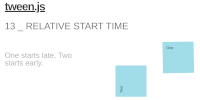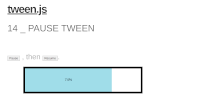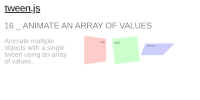
Research
Security News
Malicious npm Packages Inject SSH Backdoors via Typosquatted Libraries
Socket’s threat research team has detected six malicious npm packages typosquatting popular libraries to insert SSH backdoors.
@tweenjs/tween.js
Advanced tools
Simple and fast tweening engine with optimised Robert Penner's equations.
@tweenjs/tween.js is a simple but powerful tweening engine for JavaScript. It allows you to create smooth animations by interpolating between values over time. This can be used for animating properties of objects, such as position, scale, rotation, and more.
Basic Tweening
This code demonstrates basic tweening where an object's properties (x and y coordinates) are animated from one state to another over a duration of 1000 milliseconds.
const TWEEN = require('@tweenjs/tween.js');
let coords = { x: 0, y: 0 };
let tween = new TWEEN.Tween(coords)
.to({ x: 100, y: 100 }, 1000)
.onUpdate(() => {
console.log(coords);
})
.start();
function animate(time) {
requestAnimationFrame(animate);
TWEEN.update(time);
}
requestAnimationFrame(animate);Easing Functions
This code demonstrates the use of easing functions to create more natural motion. The Quadratic.Out easing function is used to slow down the animation towards the end.
const TWEEN = require('@tweenjs/tween.js');
let coords = { x: 0, y: 0 };
let tween = new TWEEN.Tween(coords)
.to({ x: 100, y: 100 }, 1000)
.easing(TWEEN.Easing.Quadratic.Out)
.onUpdate(() => {
console.log(coords);
})
.start();
function animate(time) {
requestAnimationFrame(animate);
TWEEN.update(time);
}
requestAnimationFrame(animate);Chaining Tweens
This code demonstrates chaining tweens, where one tween starts after another finishes. The x coordinate is animated first, followed by the y coordinate.
const TWEEN = require('@tweenjs/tween.js');
let coords = { x: 0, y: 0 };
let tween1 = new TWEEN.Tween(coords)
.to({ x: 100 }, 1000);
let tween2 = new TWEEN.Tween(coords)
.to({ y: 100 }, 1000);
tween1.chain(tween2);
tween1.start();
function animate(time) {
requestAnimationFrame(animate);
TWEEN.update(time);
}
requestAnimationFrame(animate);GSAP (GreenSock Animation Platform) is a robust and high-performance JavaScript animation library. It offers more features and flexibility compared to @tweenjs/tween.js, including timeline management, advanced easing, and support for SVG animations.
Anime.js is a lightweight JavaScript animation library with a simple API. It supports various types of animations, including CSS properties, SVG, DOM attributes, and JavaScript objects. It is more feature-rich and versatile compared to @tweenjs/tween.js.
Popmotion is a functional, flexible JavaScript animation library. It provides a range of tools for creating animations and interactions, including physics-based animations. It offers more advanced features and flexibility compared to @tweenjs/tween.js.
JavaScript (TypeScript) tweening engine for easy animations, incorporating optimised Robert Penner's equations.
<div id="box"></div>
<style>
#box {
background-color: deeppink;
width: 100px;
height: 100px;
}
</style>
<script type="module">
import {Tween, Easing} from 'https://unpkg.com/@tweenjs/tween.js@23.1.3/dist/tween.esm.js'
const box = document.getElementById('box') // Get the element we want to animate.
const coords = {x: 0, y: 0} // Start at (0, 0)
const tween = new Tween(coords, false) // Create a new tween that modifies 'coords'.
.to({x: 300, y: 200}, 1000) // Move to (300, 200) in 1 second.
.easing(Easing.Quadratic.InOut) // Use an easing function to make the animation smooth.
.onUpdate(() => {
// Called after tween.js updates 'coords'.
// Move 'box' to the position described by 'coords' with a CSS translation.
box.style.setProperty('transform', 'translate(' + coords.x + 'px, ' + coords.y + 'px)')
})
.start() // Start the tween immediately.
// Setup the animation loop.
function animate(time) {
tween.update(time)
requestAnimationFrame(animate)
}
requestAnimationFrame(animate)
</script>
px)

|
hello world (source) |

|
Bars (source) |

|
Black and red (source) |

|
Graphs (source) |

|
Simplest possible example (source) |

|
Video and time (source) |

|
Array interpolation (source) |

|
Dynamic to, object (source) |

|
Dynamic to, interpolation array (source) |

|
Dynamic to, large interpolation array (source) |

|
Repeat (source) |

|
Relative values (source) |

|
Yoyo (source) |

|
Stop all chained tweens (source) |

|
Custom functions (source) |

|
Relative start time (source) |

|
Pause tween (source) |

|
Complex properties (source) |

|
Animate an array of values (source) |
The recommended method is to use import syntax. Here we've listed various
install methods starting roughly with the most recommended first and least
desirable last. Evaluate all of the following methods to pick what is most
suitable for your project.
npm install and import from node_modulesYou can add tween.js as an npm dependency:
npm install @tweenjs/tween.js
You can import from node_modules if you serve node_modules as part of your
website, using a standard importmap script tag. First, assuming node_modules
is at the root of your website, you can write an import map like so in your HTML
file:
<script type="importmap">
{
"imports": {
"@tweenjs/tween.js": "/node_modules/@tweenjs/tween.js/dist/tween.esm.js"
}
}
</script>
Now in any of your module scripts you can import Tween.js by its package name:
<script type="module">
import {Tween} from '@tweenjs/tween.js'
</script>
Note that, without the importmap, you can import directly from a CDN as with the first example above, like so:
<script type="module">
import {Tween} from 'https://unpkg.com/browse/@tweenjs/tween.js@23.1.3/dist/tween.esm.js'
</script>
You can also link your importmap to the CDN instead of a local node_modules folder, if you prefer that:
<script type="importmap">
{
"imports": {
"@tweenjs/tween.js": "https://unpkg.com/browse/@tweenjs/tween.js@23.1.3/dist/tween.esm.js"
}
}
</script>
<script type="module">
import {Tween} from '@tweenjs/tween.js'
</script>
If you are using Node.js,
Parcel, Webpack,
Rollup, Vite, or another build
tool, then you can install @tweenjs/tween.js with npm install @tweenjs/tween.js, and import the library into your JavaScript (or
TypeScript) file, and the build tool will know how to find the source code from
node_modules without needing to create an importmap script:
import * as TWEEN from '@tweenjs/tween.js'
However, note that this approach requires always running a build tool for your
app to work, while the importmap approach will simply work without any build
tools as a simple static HTML site.
Another approach is to download the source code with git, manually build the library, then place the output in your project. Node.js is required for this.
git clone https://github.com/tweenjs/tween.js
cd tween.js
npm install
npm run build
This will create some builds in the dist directory. There are currently two different builds of the library:
/dist/tween.esm.js (recommended)/dist/tween.umd.js (deprecated, will be removed in a future major version)You are now able to copy one of those two files into your project, and use like this (recommended):
<script type="module">
import {Tween} from 'path/to/tween.esm.js'
</script>
or (deprecated, to be removed in future major):
<script src="path/to/tween.umd.js"></script>
<script>
const {Tween} = TWEEN
</script>
where path/to is replaced with the location where you placed the file.
[!Note] You can also download these files from unpkg, for example here: https://unpkg.com/browse/@tweenjs/tween.js@23.1.3/dist/
[!Note] This method is deprecated and will be removed in a future major version!
Install a global TWEEN variable from a content-delivery network (CDN) using the UMD file.
From cdnjs:
<script src="https://cdnjs.cloudflare.com/ajax/libs/tween.js/23.1.3/tween.umd.js"></script>
Or from unpkg.com:
<script src="https://unpkg.com/@tweenjs/tween.js@^23.1.3/dist/tween.umd.js"></script>
Then use the TWEEN variable in any script:
<script>
const {Tween, Easing, Group /*, ...*/} = TWEEN
const tween = new Tween(someObject)
// ...
</script>
[!Note] unpkg.com supports a semver version in the URL, where the
^in the URL tells unpkg to give you the latest version 20.x.x.
Skip this section if you don't know what CommonJS is!
[!Note] This method is deprecated and will be removed in a future major version!
Any of the above methods work in older systems that still use CommonJS. Repeat
any of the above methods but using dist/tween.cjs instead of
dist/tween.esm.js or dist/tween.umd.js.
You need to install npm first--this comes with node.js, so install that one first. Then, cd to tween.js's (or wherever you cloned the repo) directory and run:
npm install
To run the tests run:
npm test
If you want to add any feature or change existing features, you must run the
tests to make sure you didn't break anything else. Any pull request (PR) needs
to have updated passing tests for feature changes (or new passing tests for new
features or fixes) in src/tests.ts to be accepted. See
contributing for more information.
Maintainers: Joe Pea (@trusktr).
FAQs
Simple and fast tweening engine with optimised Robert Penner's equations.
The npm package @tweenjs/tween.js receives a total of 512,090 weekly downloads. As such, @tweenjs/tween.js popularity was classified as popular.
We found that @tweenjs/tween.js demonstrated a healthy version release cadence and project activity because the last version was released less than a year ago. It has 4 open source maintainers collaborating on the project.
Did you know?

Socket for GitHub automatically highlights issues in each pull request and monitors the health of all your open source dependencies. Discover the contents of your packages and block harmful activity before you install or update your dependencies.

Research
Security News
Socket’s threat research team has detected six malicious npm packages typosquatting popular libraries to insert SSH backdoors.

Security News
MITRE's 2024 CWE Top 25 highlights critical software vulnerabilities like XSS, SQL Injection, and CSRF, reflecting shifts due to a refined ranking methodology.

Security News
In this segment of the Risky Business podcast, Feross Aboukhadijeh and Patrick Gray discuss the challenges of tracking malware discovered in open source softare.